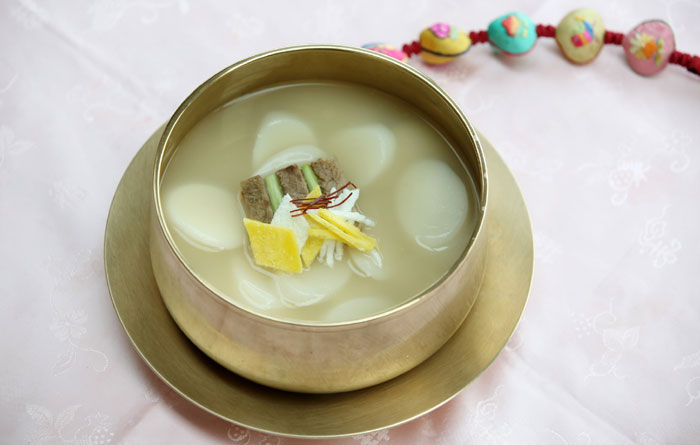
Tteokguk is one of the most symbolic dishes for Seollal. The soup represents the revival of all of Earth's creatures, new beginnings and becoming new and fresh.
Tteokguk symbolizes the Seollal lunar new year, and this dish reminds us of the meaning of New Year's and the meaning of family. The dish represents all the good luck in the coming year. Garaetteok, the main ingredient of the dish, is rice cake dough that has been pulled into long strips in a wish to lengthen one’s fortune, like the long strip of rice cake dough. The dough roll is sliced into small coin-shaped pieces, similar to the shape of Korea’s old coin currency, yeopjeon. During the reign of King Sunjo (1790-1834), the scholar Hong Seok-mo (1781-1850) (홍석모, 洪錫謨) wrote about the first month of the year in the “Dongguk-sesigi” (1849) (동국세시기, 東國歲時記), saying that, “Koreans cook the rice soup with coin-shaped, sliced rice cakes.”
Tteokguk also represents rebirth, as well as expanding one’s property. Historian and publisher Choe Nam-seon (1890-1957) (최남선, 崔南善) wrote in the “Joseon Sangsik Mundap” (조선 상식 문답, 朝鮮 常識 問答), or "The Customs of Joseon,” that, “Tteokguk originates from ritual food prepared for ancestral rites in ancient times. Eating a white food to begin the new year holds the religious meaning of rebirth for all creatures in the world.” According to the book, the white tteok represents becoming new and new beginnings. So eating tteokguk means you will begin the new year with a mind of purity and cleanness.
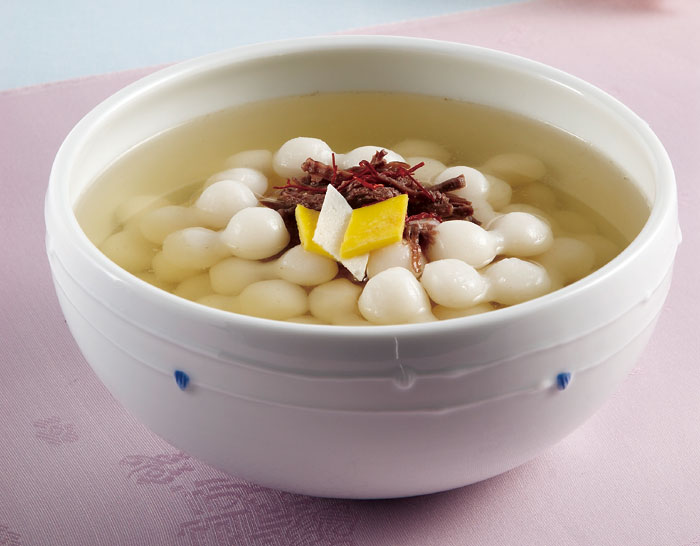
Jogaengi tteokguk is named after the shape of the rice cake pieces, which look like small gourds.
The ingredients and taste of tteokguk varies by region. In northern regions, especially north of Seoul, more people eat manduguk, a dumpling soup, than tteokguk on Seollal day. In Gaeseong, people traditionally eat jogaengi tteokguk, a New Year's soup with specially shaped pieces of rice cake. It's named for the shape of the rice cake pieces, which look like small gourds.
** Ingredients
600 grams white rice cake
300 grams beef (brisket or shank preferably)
1.6 kilograms (8 cups) water
Fragrant seasoning:
20 grams green onion
10 grams garlic
Seasoning sauce:
3 grams clear soy sauce
1.1 grams (0.25 teaspoons) minced green onion
1.4 grams (0.25 teaspoons) minced garlic
0.1 grams black pepper
6 grams (1 teaspoon) clear soy sauce
6 grams (1.5 teaspoons) salt
20 grams green onion
60 grams (1) egg
1 gram shredded red pepper
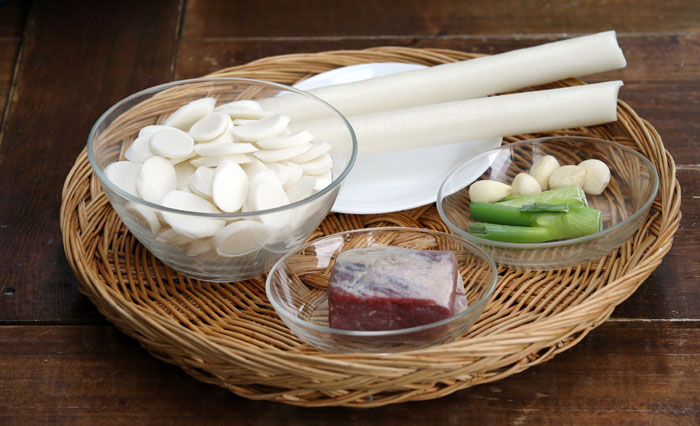
The main ingredients for tteokguk are sliced white rice cake, beef, either brisket or shank, green onions, garlic, black pepper, an egg, red chili pepper, salt and soy sauce.
** Preparation
1. Clean the blood off the beef with a cotton cloth. Cleanly wash the fragrant seasoning.
2. Put the beef and water in a pot. Heat it for 7 minutes over a high heat. When it boils, lower the heat to medium and simmer for 30 minutes. Add the fragrant seasoning and simmer for another 30 minutes.
3. Shred the white rice cake into 4-centimeter long, 0.2-centimeter thick diagonal slices.
4. Wash the green onion and cut it into 2-centimeter diagonal slices.
5. Separate the egg white and yolk and fry each separately. Cut them into 2-centimeter strips.
6. Cut the shredded red pepper into 2-centimeter slices.
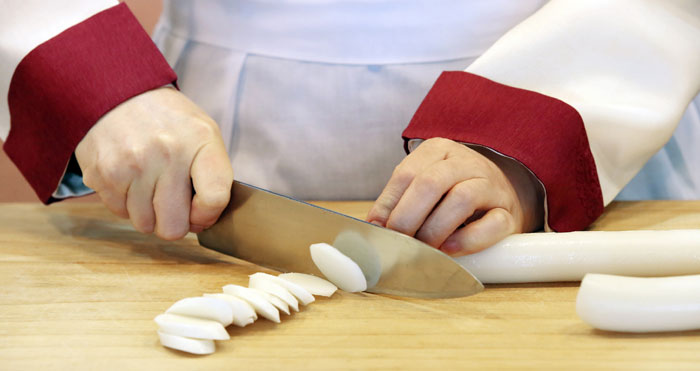
The long garaetteok needs to be sliced into round discs. The round shape of the rice cake represents wishes for good fortune.
** Recipe
1. Filter the simmered broth (1.4 kilogram) through a cotton cloth. Tear up the beef.
2. Pour the broth into a pot and heat it for 5 minutes over a high heat. When it boils, add the sliced rice cake and boil for 3 minutes. When the rice cake floats to the surface, season it with the clear soy sauce and salt. Add the green onion. Bring it to a boil once more.
3. Serve the soup in a bowl. Garnish with the beef, egg white strips, egg yolk strips and shredded red pepper slices.
Managed by Yoon Sojung
Photos: Jeon Han
Korea.net Staff Writers
In cooperation with the Institute of Traditional Korean Food (ITKF)
Recipe from “The Beauty of Korean Food: 100 Best-Loved Recipes”
arete@korea.kr
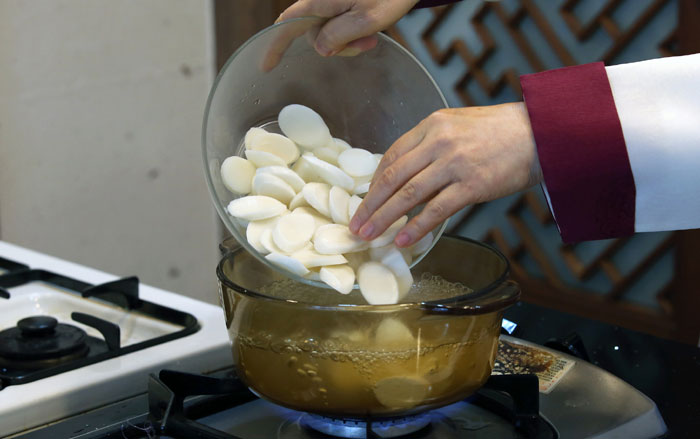
Add some soy sauce to make the soup a bit tastier. Boil it for a few minutes and add the sliced white rice cake to the boiling water. Add some salt to adjust to taste. To make the broth, you can also use simmered ox knee bone broth, brisket or shank.
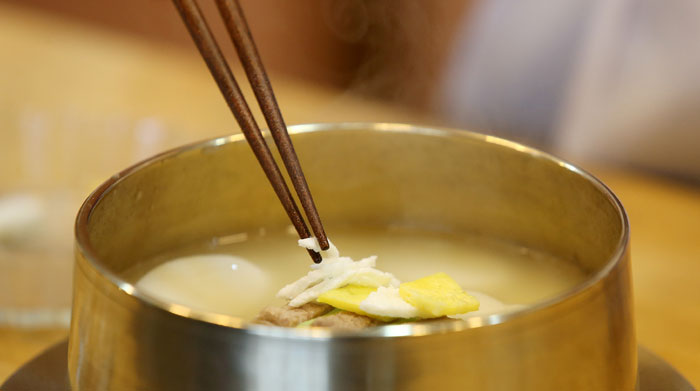
When the soup is done, serve it in a large bowl and place some beef bits, egg white slices, egg yolk slices and some red pepper on top as a garnish. You can also add some fried beef for decoration, too.